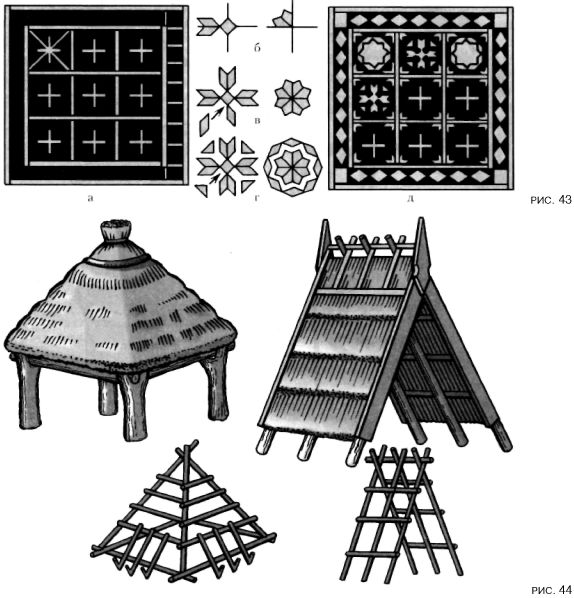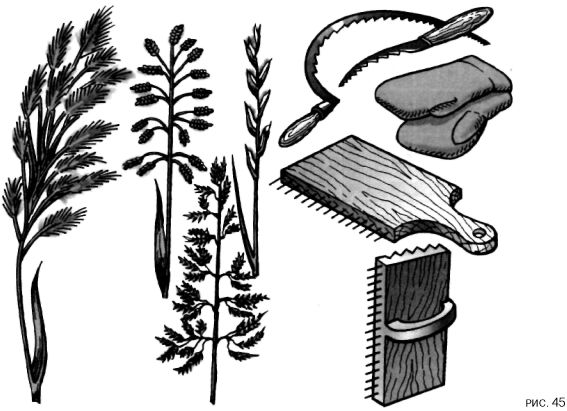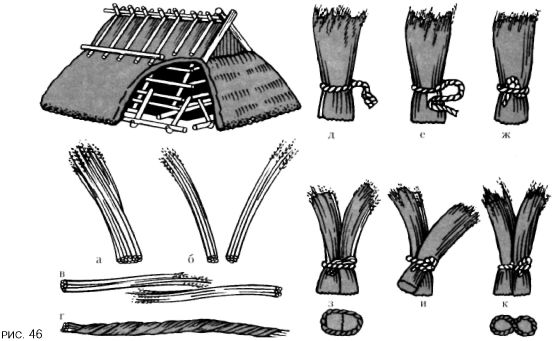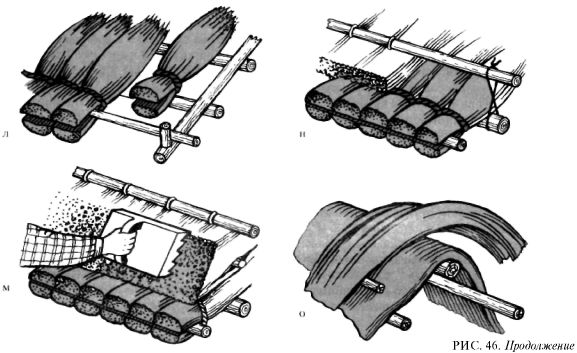London's famous globe theatre, which staged his plays of the great poet and playwright W. Shakespeare, too, was covered with straw. However, in 1613 during a performance of the play Henry VIII straw in some way contributed to the fire, but it was still carelessness. From cannon shots, which were supposed to produce in the course of the play, the thatched roof caught fire — a fire destroyed a shed, under which were placed three tiers of wooden benches for spectators. When a few months later the theatre was restored, on its roof instead of straw was already tile. Meanwhile, in the peasant buildings straw for many years remained the most common roofing material in Europe.
In the early years was born in Russia saying: Sosnova basis, Yes, the ducks (roof. — G. F.) straw. It contained an obvious reference to the unreliability of straw as roofing material. Meanwhile, a roof of good-quality straw is decades and sometimes more durable than iron, wooden and even tile roofs (figure 44).

A dwelling house or outbuildings with thatched roofs are pretty rare, and then somewhere in the Outback, away from the main roads. For decades poured a roof of rain, burning sun and razmahival the wind. Over time, the straw was black, and brownish-green carapace of moss covered its Northern slope. If to pull out from eave two or three of the straw, we find that it darkened only the ends of straws and they kept the amber-yellow colour and a soft Golden glow. They are preserved as they were several debatable ago. Corruption has undergone the top layer of a thatched roof. Preserved this fragile material thanks to its skillful use, developed over centuries of practice methods of stacking straw.
Of course, at a later time, when they began to appear other roofing materials, rural builders were attracted not only by the availability and cheapness of straw. Farmers contend that under a thatched roof in winter the hut is warmer and in summer cooler. Indeed, a thick thatch layer is a perfect insulator, blocking the path of the hot summer sun, and winter cold.
Straw and nowadays it is possible to cover small buildings, designed to protect from rain and sun. This can be a gazebo or a shady canopies in the forest areas, field camps, etc.
The thatched roof is very decorative, it blends with the wood and organically fit into the surrounding nature.
In old roofing was long and straight rye straw, compressed with a sickle or mown it with a special device. Now remove the bread combine. After going through it, straw, as already mentioned, becomes wrinkled and is totally unsuitable for roofing. But instead of rye and wheat straw can be successfully applied to the stems of wild grasses — reed, Calamagrostis, lugovik, bonfire, foxtail, Timothy and many other grasses. Almost any pasture visible from afar light purple or purple-brown spots, which merge in panicles of wild grasses in late summer. Cattle will not touch hard zaberemenila stems. By the fall of panicles with stems are discolored and whitish. Harvest grains is possible until late autumn. Associated in bundles, they can be stored in the attic until next summer.
In the southern and Western areas are a common roofing material was thatch. In Ukraine it is called a reed. Reed to this day is sometimes used to cover outbuildings. It can be found almost everywhere where there is moisture, in wet meadows, swamps, ravines and ditches, along banks of rivers, streams and lakes. In the South, the cane forms huge thickets in wetlands — low swampy banks of rivers. Under favorable conditions, the cane stalks reach a height of about 5 m with a thickness of 2 cm At the top of each stalk is a dense panicle consisting of many spikelets in length from 20 to 50 cm.
Although the reeds are less durable than straw, the roof out of it, too, can stand for decades. Begin harvest in mid-summer, when the tops finally formed purple-brown panicles. In the hot summer to produce a more comfortable than in the damp: dried up swamp you can walk even without rubber boots, and compressed cane in the morning by the evening it dries up. After two days it becomes very easy, and so convenient to transport or carry to the construction site.
Cane sickle reap. If the hammer doesn't manage to find, instead, it is possible to accommodate a large table knife, better with statusisa blade having a curved edge of the tip (figure 45). Because cut cane knife with straight blade a lot more difficult than bent. Need bending the knife can be given, stachiw part of the canvas on the trodden. To the knife blade is formed a small notch, it prokovyvayut tapered part of the hammer on the anvil or the grandmother for beating the spit. Notches can be applied with a chisel. This knife, like regular hammer will not be cut and to be cut down.

Before harvesting the cane, to hands wear gloves or mittens without them for long cut the hands of sedge that typically grows with the cane.
Cuts sedge is very painful and quite a long time to heal. So just in case take a medical bandage and iodine. It is curious that Ukraine cuts sprinkled powder from overheated ears cane.
At the same time with the cane, you also need to prepare the meadow grasses (figure 45), the straw of which is used as an independent roofing material, and as auxiliary sheaves for knitting, manufacturing of seals between the layers of cane.
You will also need thin poles with a diameter from 3 to 4 cm, the so-called sergounin, or prauge. Prituri should be straight, strong and flexible. It is best to make them from willow, but can also be used a pole from aspen and alder, the narrow long pine slats. Prituri skewer sheaves of the first row, they pressed the layers of reeds or straw to legam (Latham) roof. Prituri become attached to legam thin willow rods — Vits. In contrast to those that are weaving baskets, rods for Vits does not have to be straight. They don't bark is removed and allowed all sorts of side shoots. Length vicy can reach 1 m.
Close the roof preferably in calm weather and even with the drizzle. If the material is overdried, even the weakest wind can be a hindrance. With moist material to work much easier, besides the quality of work is much higher. Therefore, before starting work, cane and straw moistened, liberally sprinkling water with a broom. A piece of grass for fabrics bundles are soaked in a trough for about 30 minutes.
The first row of roof forms an eave — the lower hanging edge of the roof. It spread from a entire associated sheaves — single or double. All sheaves need to do the same, only then the eaves will get a uniform thickness, and so neat and beautiful. Carelessly made eave might spoil the look of the entire roof.
When knitting bundles of the most versatile measuring tool is the hand. As already mentioned, the thickness of the part of the sheaf from olden times was measured by handfuls, also called the ruchenkah. A handful (hands) is a bundle of straw or reeds that you can clasp his hand. The thicker the bundle, the more parts it includes. Thicker bundles of 8-10 handfuls, used for large roofs. As for the gazebo, for example, you can tie bundles consisting of 5 handfuls of an adult. Straw plait, or svako make thickness one handful. The same bundles of reeds, containing an equal number of handfuls, you can lay on the ground in one row and as the manufacture of bundles of wet straw to tie it. More beautiful and durable roofing is produced from cane that is pre-cleared side of the leaves.
To prepare swako, in hand take a bundle of straw (figure 46 a) is equal to the thickness of one of a handful, divide it into two equal parts (figure 46 b), and then fold again into a single beam, but only the butt in the opposite side (figure 46). Due to this, the beam becomes uniform in thickness and much longer. Then proceed to curl swala. To do so without knowledge of certain techniques is not so easy, although the case seems simple.

Rational methods of twisting straw plaits, designed for binding sheaves, developed by farmers over many centuries. All movements were precise and accurate. At first all my first swiatlo had to twist slowly in order to remember the sequence of rational movements. They only give the opportunity, not very tired to associate multiple sheaves. After a short training straw plaits twist not so difficult.
Placing a bundle of straw horizontally at arm's length, retreating from the edges to the width of two hands. Firmly gripping fingers, the end of the beam in the left hand raised to shoulder height, and the beam in the right hand is lowered below the belt. The end in your right hand twist clockwise. When gently twisted, the beam will be in a vertical position, the backhand of the right hand will be facing away from himself, and left to itself. The end of a beam, clamped in his right hand slip under his arm left hand and pressed firmly by the elbow. Then lowered his right hand, intercepting its beam in place of the left hand, the fingers of which release. The end of the harness intercepts the left arm near the armpit. Then remove it from under the arms, lifting the left arm up and right down. At this stage the hands are in the initial position. If you would like to obtain more durable swallo, these movements repeat one or two more (figure 46 g).
Ready svako twisted around the prepared bundle of cane (figure 46 d), connect the ends and twist together clockwise (figure 46 e), and then bent in half and shoved under paascu (figure 46 g). This method of knitting sheaves was selected once not in vain. The fact that the reed or straw and holds it very securely and does not fall, even after lying in the roof for decades. At the same time, the node of such a sheaf if necessary, easy to untie with one hand. To do this, simply pulling the free end of swala. This is useful especially in cases when the reed or straw is served on the roof with the stalks, where they need to be easy and fast to untie.

In addition to the usual bundles, especially for eave double knit. They are well attached to legam roof, very dense and durable, moreover, they are not so easy to untie. Hence, the eave is made of them, will be reliable and durable. To get the dual sheaf, first do a normal single, not very tight bandaging his svakom. A bundle lay on the ground or on a bench, hold the knee and flatten. Dividing a bundle with your hands on two parts (figure 46 b), rotate them relative to each other by 180 degrees (figure 46). The panicles of the two parts will be directed in opposite directions. In the same direction they turn another 180 degrees. Now panicle one-half of a combine with a whisk the other. The result is two thick sheaf connected with each other one swasam (figure 46).
You can easily calculate how much you will need to impose on sheaves so that the YUS had to eave. In the ground to drive two markers at a distance of 1 m from each other. Between the pegs in a row, tightly pressed to each other, stack of harvested sheaves. Suppose the meter runs out ten sheaves, and the perimeter of the roof has a length of 8 m. So, just need to bind the sheaves 80.
Before you lift the sheaves to the roof, they need to be clear and align with the end portion. A bundle lay on the bench so that the butt part hanging over the edge. Then take in hands a shovel stuffed at the end of a comb of nails (figure 45) and comb inboard portion of the bundle, removing it from the sedge and mouldering debris of last year's cane. After cleaning the end of the level by hitting the protruding straws or reeds with a spatula.
The roof need to beat them together with an assistant. One takes the sheaves, and the other stringing them on hooks mounted on the sheathing a bit. The sheaves are placed as closely as possible to each other, while making sure that the line of the eaves was flat and horizontal (figure 46 l). If it is difficult to do by eye, then pull on the string level and are guided by it during operation.
For the second and subsequent rows apply to unrelated reeds or straw. The second row is spread so as to fully cover the butt part of swala sheaves (figure 46 meters). The roof will be much safer and stronger, if the cane is to put a layer of straw of medium thickness. If not enclose straw, then a layer of reeds make more dense. Spread out on the slope of the roof of reeds or straw pressed against legam pitohui, which tied with Vic. In forest areas prituri tied to legam fake born with a wooden Shuttle. Later began to use steel and aluminum wire. Before you get on the roof, a bundle of rods or wire tied to the waist so that they were easy to get while working.
Pressing pricego to the sheathing of the roof as tightly as possible with his knee, pushes through a layer of reeds the end of the wire or rod near petugas in the attic. Assistant, who must be in the attic, takes the end of Vice and circled it around the poles, pushes through a layer of reed or straw on the roof. On the roof of Vitu-knotted, that is, twist the two ends together and slip under Prithu. In the same manner they spread and pressed promogame all subsequent layers of reeds or straw to the horse. The rows of cane and straw will be located steps. The stepped roof is beautiful and it can be found in the peasant buildings of the European countries. But if our plans work the roof with smooth rays, you should come the so-called comb or brush (figure 46.).
Method of coating straw with the use of this tool was called a comb or a brush
The comb is a wooden Board the size of 300x250x50 mm, one side of which is cut longitudinal protrusions in the form of teeth and on the back, reinforced handle (figure 45).
One of the Board edges hammered at a distance of 30 mm from each other nails without hats. This part of the comb like comb reeds or straw, corrugated side gently chisel the ends of the cane and straw, destroying the steps and achieving a seamless transition from one layer to another. This operation is carried out before you finally tie him to legam preturi.
Complete incorporation of reed or straw on top of the roof (figure 46). On pitched roof cane bend through the upper bit first, on the one hand, and then with another. If desired, the top can make a horse out of the sheaves, set in a row. Below the horse is not swept by the wind, ears pressed against the top sheaves so-called goats, nailed or tied from poles. Links goats are harvested from poles of equal length on earth. At the lower end of each link hammered in pre-hollowed nest of wooden pins. Links raise goats on the roof and transported through the skate. The pins are placed quite heavy prituri that tightly links together with the cane to the roof slope. To the top of the goats also fit slightly.
Different tops are made conical and pyramidal roofs. On top put a bent tin or rolled into the form of a cone cap of thick bark. Can the top of to issue otherwise — as it did in the old days, that is, to impose from above a thick sheaf. He firmly stayed on him wearing a Hoop bent from thick willow branches that tie to legam thin rods or wire.



